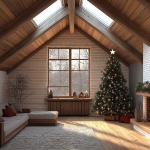
Natural light delivers ample benefits to an indoor environment. Recognizing those benefits, and understanding the best ways to bring them into your environment, will unlock a skylight’s full value.
“There are a host of physical and mental benefits that come with letting the sun inside your home or building,” says Macro Ferrazzo, a manager with Artistic Skylights. “And the more strategic you are with placing your skylights or windows, the greater those advantages will be.”
Those advantages include the following:
- Body booster: Exposure to natural light is a proven way of boosting a body’s ability to store Vitamin D, a vital micronutrient used to strengthen bones, absorb calcium, regulate critical body systems, and support the production of T-cells, which are central to healthy immune systems.
- Better sleep: Research confirms that absorbing natural light during the day contributes to a better night’s sleep. Reversely, a lack of sunlight at the office or home can adversely affect our biological clock and create negative sleeping habits.
- Natural mood enhancer: Serotonin is a hormone that facilitates calmer and more positive moods. Studies show that sunlight promotes the brain’s production of serotonin, which can be particularly useful when combatting stress, anxiety, or ailments such as Seasonal Affective Disorder.
- Staying focused: Soaking in the sun has quantifiable impacts on mental health, helping us feel more energized, alert, and ready to tackle the day.
- Taking the pressure off: Another benefit of natural light is that it has been shown to reduce blood pressure by transferring nitric oxide to our circulatory systems.
- Healthier vision: It’s never wise to stare directly at the sun. That said, consistent exposure to natural light helps towards the healthy development and maintenance of our eyes.
With the benefits of natural light in full view, the next question is how can we bring them indoors? Here’s where a little strategy can make your investment shine.
Consider the following:
Direction: Where you place your skylight will dictate how much natural light you’ll enjoy throughout the day. Skylights facing north, for example, let in consistent light around the clock while reducing heat gain, while an east-facing light grants an abundance of light and solar heat gain in the early hours. Choose a direction that fits your plans, but also consider where outdoor obstructions may block your view (e.g., trees and buildings).
Work the angles: Consult with your skylight designer, supplier, and/or installers to determine which angle for your skylight will be ideal for your space. The light coming in will differ based on the skylight’s height, positioning and the size of the ceiling opening.
Material choice: Skylights come with several options for glazing and composition. Each will impact how much natural light gets through and the resulting heat transfer. Consider each option when planning your purchase.
Read the room: A skylight can be a subtle room accent or the main feature. Think about how much sunlight you want for your space and what skylight size and design will work best with your desired aesthetic. Here again, working with designers and installers can help determine the most eye-catching solutions.
There’s little denying the power of natural light. Hopefully, these insights and tips can help you bring the exact amount of sun into your space.



